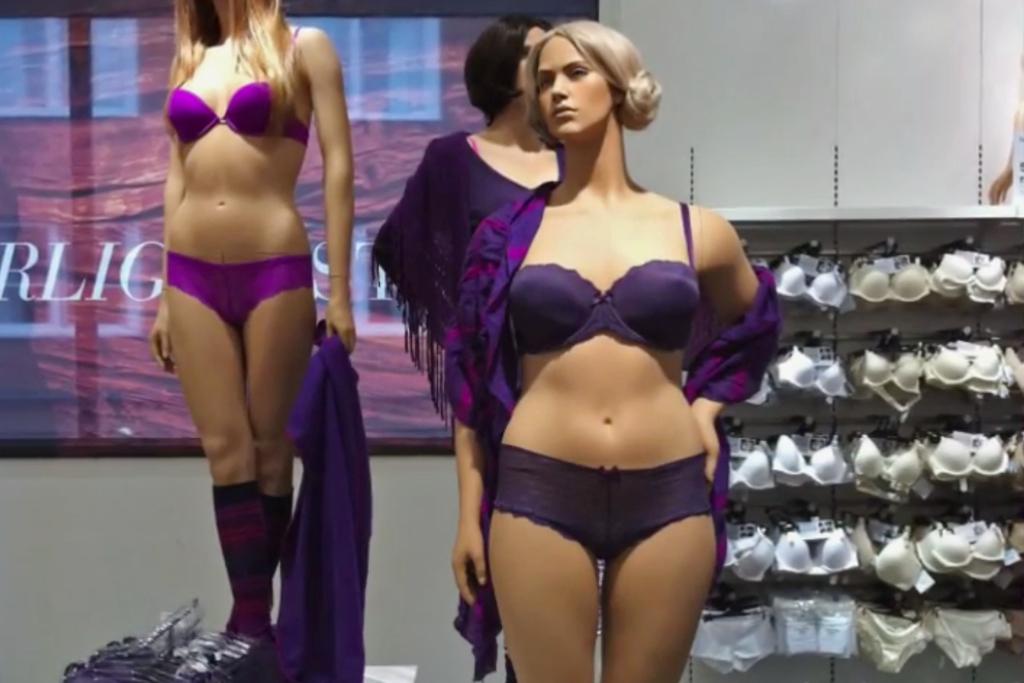Mannequins all over the world are starting to look more like us
If you google "merkin" regularly (and really, who doesn't), you may have seen Gothamist’s piece about American Apparel's NYC store. If not, let me summarize: the dummies have pubic hair. (BTW, a merkin is a flirty hairpiece that covers the bathing suit area and it was once worn by prostitutes. Not to be confused with that other Shakespearean adornment, the codpiece.)
It's a bit fuzzy why the LA-based clothing company went full lap wig. It could be the latest manifestation of pop culture retromania. It could be an ironic statement about society's obsession with bikini line maintenance — although probably not, given American Apparel's own history of hipster sexism. More likely they just wanted to push some buttons and watch Twitter explode.
These days we're swimming in fancy beards and mustaches and yet it's unlikey that merkins will catch on. But we can actually learn a lot about a culture's values based on how mannequins reflect or distort the human body. Let’s take a look at some of the recent stories from around the world:
1. Venezuela
![]()
(YouTube)
All mannequins are fake, but the ones in Venezuela take it to a new level: huge breasts, cartoonishly small waists and butts that won’t quit. The super-sexualized look is a recent development. As a manufacturer told the New York Times, “The transformation has been both of the woman and of the mannequin.” As it turns out, the older mannequins were based on European and American prototypes that didn’t necessarily conform to real bodies. But the newer models confront women with an equally unnatural physical ideal.
There’s a real concern that Venezuela's mannequins are catering to and fueling a national obsession with implants and other forms of plastic surgery. Some trace the development to Venezuela’s success in beauty pageants — and a culture of consumerism and instant gratification fueled by oil money.
More from GlobalPost: See what it's like inside one of Venezuela's beauty pageant factories
So what does Osmel Sousa, the influential director of the Miss Venezuela pageant, have to say?
“I say that inner beauty doesn't exist. That’s something that unpretty women invented to justify themselves…. In the rules of the international contest, the girls don't have to be completely natural. They have to be beautiful. But where that beauty comes from doesn't matter.”
2. Germany and Switzerland
About one billion people around the world have a disability, whether it's physical, intellectual or sensory in nature. They rarely get to experience a world designed to embrace their needs, let alone their appearance. As Jezebel notes, “fashion mannequins — the type you see constantly in clothing store windows — are generally what we think of as flawless specimens of the human form.”
So some people set out to change this. A German ad agency, Jung Von Matt/Limmat, and a Swiss disability rights organization, Pro Infirmis, wanted to remind people that beauty is not about physical perfection. They developed a series of mannequins modeled off the bodies of real people with impairments, including curved spines, shortened limbs and other mobility challenges. The results were displayed in a storefront in Zurich, Switzerland. See the stunning process above.
3. United Kingdom
![]()
(YouTube)
Last December Debenhams, one of Britain’s largest department stores, began to display “plus-sized” mannequins at its flagship location in London. How plus, you ask? The models are a UK 16 instead of 10 (in America, this would be a size 14 instead of 8). The size of the mannequins may be well above the retail industry’s average but it’s fairly standard for human beings: 45 percent of British women wear a 16 or above.
While rising obesity rates in the UK (and elsewhere) are a serious health concern, so too is the fat-shaming implicit in unrealistically thin models. The LA Times has compiled some particularly bad examples that you can see here (The Gap), here (Club Monaco) and here (JC Penney). Larger mannequins may be healthier for women's body images. They also happen to make good business sense: British women are 3 times more likely to buy clothes if a mannequin is their size.
4. Sweden
![]()
YouTube
Swedish store Åhlens was one of the first to display curvy mannequins, which it did last March. Photos quickly went viral, with thousands of women around the world celebrating the more natural proportions. As Delia Lloyd commented in the Washington Post, “It’s an encouraging sign of the times that we’re beginning to push back against the anorexic ideal that is so deeply embedded in our commercial and cultural aesthetic.”
The representativeness of mannequins and models is increasingly impacting the fashion industry, for men as well as women. In 2007, Spain’s Ministry of Health wrangled a promise out of Spanish companies to feature mannequins at least size 6 or larger. And last year in Israel, legislation took effect requiring fashion models to have a BMI of at least 18.5. For a woman who's 5'9", that's 125 lbs. (or 175 cm and 59 kg).
